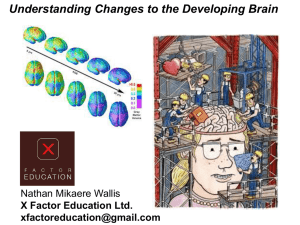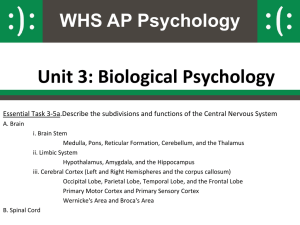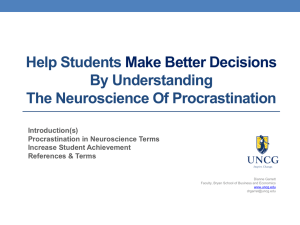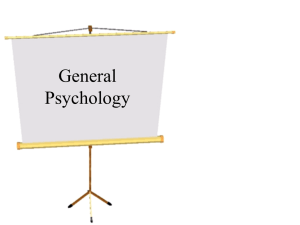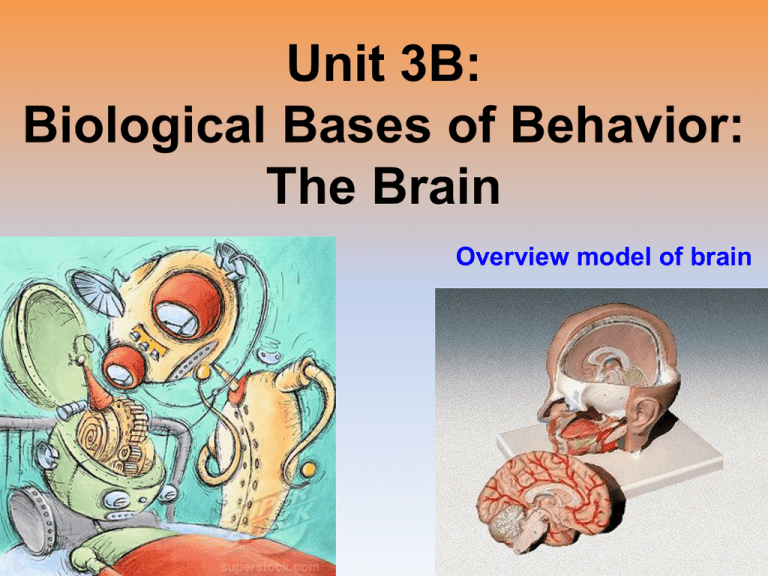
Unit 3B:
Biological Bases of Behavior:
The Brain
Overview model of brain
Unit Overview
1. The Tools of Discovery: Having Our Head
Examined
2. Brain Structures
3. The Cerebral Cortex
4. Our Divided Brain
5. Right-Left Differences
in the Intact Brain
6. The Brain and Consciousness
Click on the any of the above hyperlinks to go to that section in the presentation.
The Tools of Discovery:
Having Our Head Examined
prep DVD1, Neuroscience
and Behavior, #2
Introduction
LO #1, p. 67
• lesion
two effects of
damage to a rat’s
hypothalamus?
What are three
ways scientists can
stimulate parts of
the brain?
1.
2.
3.
Recording the Brain’s
Electrical Activity
• electroencephalogram (EEG)
How does an EEG
work?
What might it
reveal?
Rachel W. taste
Neuroimaging Techniques
• CT (Computed Tomography) scan
• PET (Positron Emission
Tomography) scan
• MRI (Magnetic
Resonance Imaging)
• fMRI (Functional MRI)
How is a CT scan different
from PET scan?
MRI from fMRI?
Structure or function?
Video: Mapping the Brain
Through Electrical Stimulation,
2:40 (DVD1, Neuroscience and
Behavior, clip 05, p. 13)
prep Vol. 2, DVD1 (Neuroscience and Behavior), Clip 106
Brain Structures
The Brainstem
LO #2 – importance of lower-level brain structures
• brainstem
–medulla
–pons (relays signals from
forebrain to the cerebellum
–reticular formation
The Thalamus
• thalamus
–all the senses
EXCEPT smell;
(brain’s sensory
switchboard or
post office)
The Cerebellum
• cerebellum
–“little brain”
Michael Jordan
The Limbic System
• limbic System
–hippocampus
Video: Compulsive Gambling and
the Brain’s Pleasure Center
Vol. 2, DVD1 (Neuroscience and
Behavior), Clip 106, 5:20 min.
The Limbic System
The Amygdala
• amygdala
–aggression
and fear
The Limbic System
The Hypothalamus
• hypothalamus, p. 72
–influence on the pituitary gland
–reward centers
–reward deficiency
syndrome (e.g., Kim
Rainer)
Hypothalamus is responsible
for “drives” including sexual
behavior.
Yes, the hypothalamus is responsible
for “sexual behavior.”
What does THAT mean?
“. . . and the two shall become one flesh.”
Review of web site
www.pureintimacy.org
Click on God’s design for sex
Then on What’s Good About Sex
The Cerebral Cortex
prep Phineas Gage video
Introduction
LO #3 – cerebral cortex regions
• cerebrum – the two large hemispheres
–cerebral cortex
thin surface layer
Structure of the Cortex
• glial cells (“glue cells”)
• lobes
–frontal lobe
–parietal lobe
–occipital lobe
–temporal lobe
Functions of the Cortex
Motor Functions
• motor cortex
• mapping the
motor cortex
(surgery humor)
• neural
prosthetics
(paralyzed 25-yr.
old man)
Functions of the Cortex
Sensory Functions
• sensory
cortex
(brain model)
Lobes of the
Cerebral Cortex
For each statement, identify
the lobe that has the primary
responsibility for that activity
or experience.
A
Temporal
Listening to music
Frontal
Waving your arm
Parietal
Feeling gloves on your hands
Occipital
Viewing a sunset
Temporal
Frontal
Occipital
Parietal
Hearing your name being called
Making plans for dinner
Seeing your friend’s face
Experiencing an itch
B
D
C
Functions of the Cortex
Association Areas
• association areas
–frontal lobe (motor strip)
–Phineas Gage
(demo of frontal association
area at work)
–parietal lobe (sensory
strip)
–temporal lobe
(brain model)
Video: Phineas Gage
then prep DVD1, Neuroscience and Behavior, clip 06
Video: Planning, Life Goals,
and the Frontal Lobe, (DVD1,
Neuroscience and Behavior, clip 06, p. 14, 6:20)
(Vietnam veteran)
Language
LO #4 – areas of language processing
• aphasia, p. 80
–Broca’s area (damage disrupts speaking)
–Wernicke’s area (damage disrupts understanding)
Language, p. 81
prep DVD1, Neuroscience and Behavior, clip 08
Language
Language
Language
Language
Language
Video: Language and Brain Plasticity,
4:00 (DVD1, Neuroscience and Behavior,
clip 08, p. 18)
prep “Split Brain”
The Brain’s Plasticity
LO #5 – reorganization of damaged brain
• brain damage
–plasticity
(ability to modify itself after . . .)
–constraint-induced
therapy (forced use of . . .)
–neurogenesis
(generate new brain cells)
Our Divided Brain
Splitting the Brain
LO #6 – what split brains reveal
• Vogel and Bogen, p. 83
–corpus-callosum
–split brain (result?)
–Myers and Gazzaniga
(brains of cats and monkeys)
Video: Split Brain, 12:26
Right-Left Differences in the
Intact Brain
How Smart Is Your Right Foot?
While sitting at your desk, lift your
right foot off the floor and make
clockwise circles with it.
Now, while doing this, draw the
number "6" in the air with your right
hand. What happens?
Right-Left Brain Differences
LO #7 – handedness
• hemispheric specialization, p. 87
–perceptual tasks (right)
–language (effect of sedative to left hemisphere)
ACTIVITY
Handout 3B-4
The Wagner Preference Inventory
Hand Usage Questionnaire
With which hand do you . . .
1. Draw?
Left
Right
Either
2. Write?
Left
Right
Either
3. Use a bottle opener?
Left
Right
Either
4. Throw a snowball?
Left
Right
Either
5. Use a hammer?
Left
Right
Either
6. Use a toothbrush?
Left
Right
Either
7. Use a screwdriver?
Left
Right
Either
8. Use an eraser on paper?
Left
Right
Either
9. Use a tennis racket?
Left
Right
Either
10. Use a scissors?
Left
Right
Either
11. Stir a can of paint?
Left
Right
Either
12. On which do you rest
a bat before swinging?
Left
Right
Either
Hemisphere Activity Demonstration
The Brain and Consciousness
Introduction
LO #8 – dual processing
• consciousness, p.89
(two proposed
advantages)
- helps us act
in long-term
interests
- promotes
survival
Cognitive Neuroscience
• cognitive neuroscience
(interdisciplinary study)
View CT scan images
Dual Processing
• dual processing, p. 90
–conscious left brain
conscious deliberate “high road”
–intuitive right brain
unconscious, automatic
“low road”
• visual perception track
• visual action track clip
Corpus callosum
Thalamus
Hypothalamus
Pituitary
A. Amygdala
C. Reticular formation
D. Medulla
B. Hippocampus
Spinal cord
E. Cerebellum
Activation of this area would result in:
coordinated movement
anger
waking up from a nap
a steady heartbeat
the ability to remember what you did two minutes ago
Cerebral cortex
Corpus callosum
Thalamus
Hypothalamus
Pituitary
A. Amygdala
C. Reticular formation
D. Medulla
B. Hippocampus
Spinal cord
E. Cerebellum
Damage to this area would result in:
not breathing
stumbling
an inability to store new memories
being unable to wake up
an inability to feel fear
Cerebral cortex
A. Corpus callosum
B. Thalamus
C. Hypothalamus
Pituitary
Amygdala
Reticular formation
Medulla
Hippocampus
D. Spinal cord
Cerebellum
Activation of this area would result in:
the maintenance of body temperature.
recalling old memories.
your brain being able to tell your legs to move.
the routing of visual signals to the occipital lobe.
communication between the two hemispheres
E. Cerebral cortex
A. Corpus callosum
B. Thalamus
C. Hypothalamus
Pituitary
Amygdala
Reticular formation
Medulla
Hippocampus
D. Spinal cord
Cerebellum
Damage to this area would result in:
a split brain.
inoperative reward centers.
your feet being unable to tell your brain you’re wearing socks.
an inability to send auditory signals to your temporal lobes.
an altered personality.
E. Cerebral cortex
Test Time!
• Types of Files
Teacher Information
– This presentation has been saved as a “basic” Powerpoint file. While this file
format placed a few limitations on the presentation, it insured the file would be
compatible with the many versions of Powerpoint teachers use. To add
functionality to the presentation, teachers may want to save the file for their
specific version of Powerpoint.
• Animation
– Once again, to insure compatibility with all versions of Powerpoint, none of the
slides are animated. To increase student interest, it is suggested teachers
animate the slides wherever possible.
• Adding slides to this presentation
– Teachers are encouraged to adapt this presentation to their personal teaching
style. To help keep a sense of continuity, blank slides which can be copied and
pasted to a specific location in the presentation follow this “Teacher
Information” section.
Teacher Information
• Hyperlink Slides - This presentation contain two types of hyperlinks. Hyperlinks
can be identified by the text being underlined and a different color (usually purple).
– Unit subsections hyperlinks: Immediately after the unit title slide, a page (slide
#3) can be found listing all of the unit’s subsections. While in slide show mode,
clicking on any of these hyperlinks will take the user directly to the beginning of
that subsection. This allows teachers quick access to each subsection.
– Bold print term hyperlinks: Every bold print term from the unit is included in
this presentation as a hyperlink. While in slide show mode, clicking on any of
the hyperlinks will take the user to a slide containing the formal definition of
the term. Clicking on the “arrow” in the bottom left corner of the definition
slide will take the user back to the original point in the presentation.
These hyperlinks were included for teachers who want students to see or copy
down the exact definition as stated in the text. Most teachers prefer the
definitions not be included to prevent students from only “copying down what
is on the screen” and not actively listening to the presentation.
For teachers who continually use the Bold Print Term Hyperlinks option, please
contact the author using the email address on the next slide to learn a
technique to expedite the returning to the original point in the presentation.
Teacher Information
• Continuity slides
– Throughout this presentation there are slides, usually of graphics or tables, that
build on one another. These are included for three purposes.
• By presenting information in small chunks, students will find it easier to process and
remember the concepts.
• By continually changing slides, students will stay interested in the presentation.
• To facilitate class discussion and critical thinking. Students should be encouraged to think
about “what might come next” in the series of slides.
• Please feel free to contact me at kkorek@germantown.k12.wi.us with
any questions, concerns, suggestions, etc. regarding these
presentations.
Kent Korek
Germantown High School
Germantown, WI 53022
262-253-3400
kkorek@germantown.k12.wi.us
Division title (green print)
subdivision title (blue print)
• xxx
–xxx
–xxx
Division title (green print)
subdivision title (blue print)
Use this slide to add a table, chart, clip art, picture, diagram, or video clip. Delete
this box when finished
Definition Slide
= add definition here
Definition
Slides
Lesion
= tissue destruction; a brain lesion is a
naturally or experimentally caused
destruction of brain tissue.
Electroencephalogram (EEG)
= an amplified recording of the waves of
electrical activity that sweep across the
brain’s surface. These waves are
measured by electrodes placed on the
scalp.
CT (computed tomography)
Scan
= a series of X-ray photographs taken from
different angles and combined by
computer into a composite representation
of a slice through the body.
• Also called CAT scan.
PET (positron emission
tomography) Scan
= a visual display of brain activity that
detects where a radioactive form of
glucose goes while the brain performs a
given task.
MRI (magnetic resonance
imaging)
= a technique that uses magnetic fields and
radio waves to produce computergenerated images of soft tissue. MRI
scans show brain anatomy.
fMRI (functional MRI)
= a technique for revealing bloodflow and,
therefore, brain activity by comparing
successive MRI scans. fMRI scans show
brain function.
Brainstem
= the central core of the brain, beginning
where the spinal cord swells as it enters
the skull; the brainstem is responsible for
automatic survival functions.
Medulla
= the base of the brainstem; controls
heartbeat and breathing.
Reticular Formation
= a nerve network in the brainstem that
plays an important role in controlling
arousal.
Thalamus
= the brain’s sensory switchboard, located
on top of the brainstem; it directs
messages to the sensory receiving areas
in the cortex and transmits replies to the
cerebellum and medulla.
Cerebellum
= the “little brain” at the rear of the
brainstem; functions include processing
sensory input and coordinating movement
output and balance.
Limbic System
= doughnut-shaped neural system (including
the hippocampus, amygdala, and
hypothalamus) located below the cerebral
hemispheres; associated with emotions
and drives.
Amygdala
= two lima bean-sized neural clusters in the
limbic system; linked to emotion.
Hypothalamus
= a neural structure lying below (hypo) the
thalamus; it directs several maintenance
activities (eating, drinking, body
temperature, sexual behavior), helps
govern the endocrine system via the
pituitary gland, and is linked to emotion
and reward.
Cerebral Cortex
= the intricate fabric of interconnected neural
cells covering the cerebral hemispheres;
the body’s ultimate control and
information-processing center.
Glial Cells
= cells in the nervous system that support,
nourish, and protect neurons.
Frontal Lobe
= portion of the cerebral cortex lying just
behind the forehead; involved in speaking
and muscle movements and in making
plans and judgments.
Parietal Lobe
= portion of the cerebral cortex lying at the
top of the head and toward the rear;
receives sensory input for touch and body
position.
Occipital Lobe
= portion of the cerebral cortex lying at the
back of the head; includes areas that
receive information from the visual fields.
Temporal Lobe
= portion of the cerebral cortex lying roughly
above the ears; includes the auditory
areas, each receiving information primarily
from the opposite ear.
Motor Cortex
= an area at the rear of the frontal lobes that
controls voluntary movements.
Sensory Cortex
= area at the front of the parietal lobes that
registers and processes body touch and
movement sensations.
Association Areas
= areas of the cerebral cortex that are not
involved in primary motor or sensory
functions; rather, they are involved in
higher mental functions such as learning,
remembering, thinking, and speaking.
Aphasia
= impairment of language, usually caused by
left hemisphere damage either to Broca’s
area (impairing speaking) or to Wernicke’s
area (impairing understanding).
Broca’s Area
= controls language expression that directs
the muscle movements involved in
speech.
Wernicke’s Area
= controls language reception – a brain area
involved in language comprehension and
expression; usually in the left temporal
lobe.
Plasticity
= the brain’s ability to change, especially
during childhood, by reorganizing after
damage or by building new pathways
based on experience.
Neurogenesis
= the formation of new neurons.
Corpus Callosum
= the large band of neural fibers connecting
the two brain hemispheres and carrying
messages between them.
Split Brain
= a condition resulting from surgery that
isolates the brain’s two hemispheres by
cutting the fibers (mainly those of the
corpus callosum) connecting them.
Consciousness
= our awareness of ourselves and our
environment.
Cognitive Neuroscience
= the interdisciplinary study of the brain
activity linked with cognition (including
perception, thinking, memory and
language).
Dual Processing
=the principle that information is often
simultaneously processed on separate
conscious and unconscious tracks.




